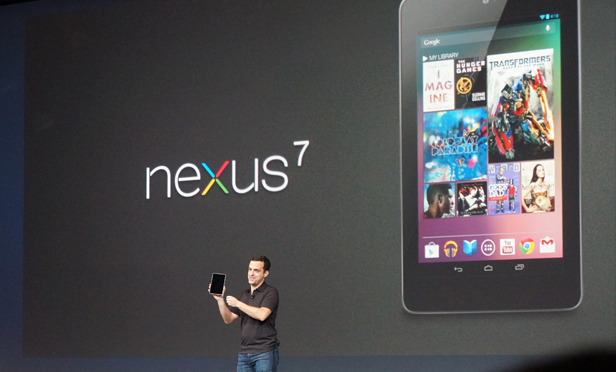Google Would Like to Sell You a Tablet

Today, Google unveiled a seven-inch tablet computer that it will sell directly to consumers. The device, unveiled at the company’s annual I/O conference in San Francisco, was pitched not as a competitor with Apple’s popular iPad, but as a simple way to enjoy movies, books, games, and other content bought through Google’s Play store.
That makes the tablet, priced at $199, a close match to Amazon’s Kindle Fire, launched in September of last year. That tablet also has a seven-inch screen and is also centered on consuming digital content. Google’s price includes a $25 credit to spend on apps and content.
Google will begin taking orders for Nexus 7 tablets starting today and will ship them in “mid-July,” said Hugo Barra, director of product management for Google’s Android mobile operating system. “It’s a tablet optimized around all of this content in Google Play,” he said. “We partnered with a great company, Asus, to help us build just that device.”
Barra said that Nexus 7 offers up to nine hours of video playback and 300 hours of standby time. “It’s only 340 grams—just about the weight of a standard paperback,” he said. The Nexus 7 will initially be available only in the U.S., U.K., Canada, and Australia.
Barra emphasized that the device is powerful enough for high-end gaming, and introduced demonstrations of rich, 3-D games with sophisticated lighting, water, and fog effects. The Nexus 7’s Nvidia Tegra 3 quad-core chip and 12-core GPU makes it more powerful than Amazon’s tablet, which can’t run high-end games. However, Amazon is expected to release a more powerful version of the Fire before the end of the year.
Google has tried to sell gadgets directly to consumers before, without success. In 2010, the company began selling the Nexus One smart phone online, in an attempt to boost the popularity of the Android mobile operating system and to shift the mobile industry away from carrier-controlled contracts. But Google was unprepared for the onslaught of customer-service requests it received after the gadget reached people’s hands, and the venture didn’t convince large numbers of people to embrace the notion of buying a phone without a service agreement. Google’s Nexus One experiment ended after just six months.
The relatively simple tablet is also a departure from Google’s previous attempts to reinvent what people get from computers. Both the version of Android for tablets and the browser-only Chrome OS that powers the stripped-down laptops dubbed Chromebooks present complicated and relatively unpopular experiences compared to Apple’s iPad. The Nexus 7 was not talked about as a general purpose computing device to be used for activities such as creating and editing documents, signaling that it is not intended to compete with the iPad.
Amazon is known to have sold many millions of its Fire tablets, but it does not report sales figures for that product or any of its black-and-white Kindle e-readers. A report by Oregon investment bank Pacific Crest this week said that based on the demand for components used to make Amazon’s Kindle products, demand for the Fire is growing at 60 percent annually while demand for black-and-white e-readers is falling back.
In a report published before Google’s tablet was announced, Gartner predicted that 118.9 million tablets will be sold worldwide in 2012, almost double the number sold in 2011.
The Nexus 7 will ship with a new version of Google’s Android mobile operating system called Jelly Bean. As well as various improvements and new features, Jelly Bean introduces upgrades that promise to match or exceed Apple’s Siri personal assistant. A Google Search app can answer some spoken questions by making use of the company’s new Knowledge Graph. A user can speak a query, for example, “Who is the prime minister of Japan?” and the phone speaks the answer right back.
Another search feature in Jelly Bean, called Google Now, goes further, and it is a striking illustration of how much Google knows about Web users. It uses the history of a person’s Google searches to predict what a person needs to know before they ask. When you open the app, it can show sports scores for teams you have searched for in the past, or the latest update on a flight you searched for yesterday. Google Now will also work out your usual commute and advise when bad traffic means you should change it; and it will bring up translation and currency conversion tools when the phone detects that you’ve traveled abroad.
Underlining Google’s commitment to making its Play store a popular place to buy digital content, the company also showed a spherical gadget dubbed Nexus Q. It is designed to to connect to a TV and hi-fi speakers to play content bought through the Google Play store. The device is controlled using an Android smart phone or tablet.
Keep Reading
Most Popular
Large language models can do jaw-dropping things. But nobody knows exactly why.
And that's a problem. Figuring it out is one of the biggest scientific puzzles of our time and a crucial step towards controlling more powerful future models.
The problem with plug-in hybrids? Their drivers.
Plug-in hybrids are often sold as a transition to EVs, but new data from Europe shows we’re still underestimating the emissions they produce.
Google DeepMind’s new generative model makes Super Mario–like games from scratch
Genie learns how to control games by watching hours and hours of video. It could help train next-gen robots too.
How scientists traced a mysterious covid case back to six toilets
When wastewater surveillance turns into a hunt for a single infected individual, the ethics get tricky.
Stay connected
Get the latest updates from
MIT Technology Review
Discover special offers, top stories, upcoming events, and more.